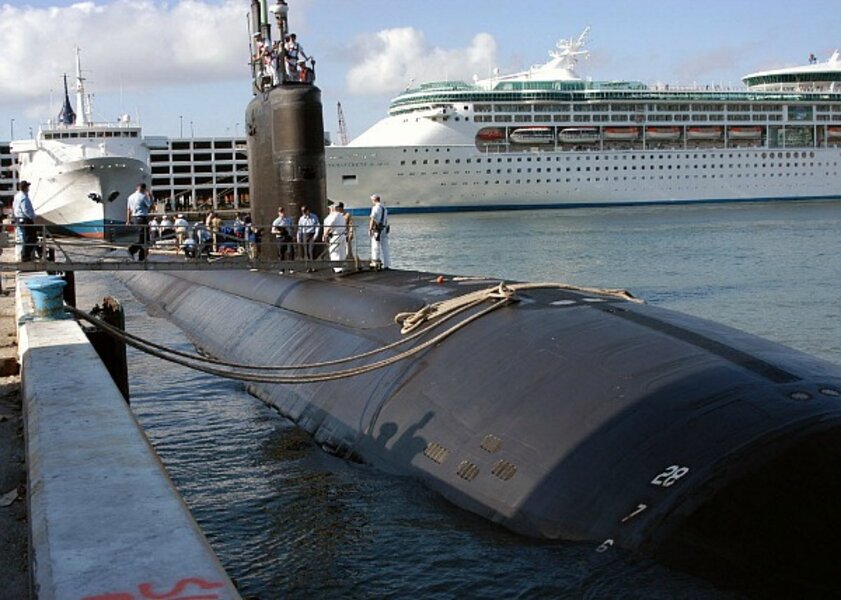Sub fire could have ripple effects for Navy fleet
Loading...
| HARTFORD, Conn.
The Navy is evaluating whether it's worth spending millions of dollars to repair the USS Miami, the nuclear-powered submarine damaged in a fire in a Maine shipyard.
If the submarine is scrapped, the fleet could feel the effects for years. The number of attack submarines like the Miami is projected to drop as they are deactivated faster than they are replaced, and Navy leaders already have been trying to find new ways to keep up with demands from combatant commanders.
"It's strained now," said Rep. Joe Courtney, a Democrat whose eastern Connecticut district includes the Miami's home port of Groton. "With one less boat, it's just going to aggravate that strain."
The Miami was in dry dock at Portsmouth Naval Shipyard in Kittery, Maine, for an overhaul when the fire broke out May 23, damaging the torpedo room and command area inside the sub's forward compartment. The cause is under investigation. Navy officials say it will be about two weeks before an announcement on whether the submarine will sail again.
The Navy has been counting on the Los Angeles-class submarine to provide another nine or so years of service. Built for $900 million and commissioned in 1990, it is among the older boats in a fleet of about 54 U.S. attack submarines, which are used to launch missiles, gather intelligence and support other Navy vessels.
As the number of attack subs has declined since the end of the Cold War, the Navy has been exploring several options to wring more service from each submarine. Deployments that typically last six months have been stretched in some cases to seven, and the force has been looking into repositioning submarines around the globe to reduce transit times and pressing builders to reduce maintenance periods.
Ronald O'Rourke, a naval affairs specialist with the Congressional Research Service, said the loss of the Miami would put slightly more pressure on the remaining submarines to meet mission demands.
"The Navy might respond to this in part by increasing the number of instances in which attack submarines are deployed for seven months rather than six months," O'Rourke said.
Officials say the decision on whether to salvage the Miami may be a difficult one. The fire did not damage any nuclear components, but the intensity of the blaze, which burned for 10 hours, has raised concerns about potential damage to the hull.
"I know this submarine can be repaired. The only issue is cost at a time of very tight fiscal constraints," said Sen. Richard Blumenthal, a Connecticut Democrat who said preliminary estimates suggest repairing the sub could cost as much as $1 billion. "The question for the Navy will be whether repairs are cost-effective, worth the wait and the capabilities that the submarine brings to the fleet."
The fleet would not feel any impact in the near term because the Miami was three months into an overhaul that was scheduled to take 20 months, said Jan van Tol, a retired Navy captain and a senior fellow at the Center for Strategic and Budgetary Assessments in Washington. He said that any ripple effects beyond that would be minimal, but that an episode like this would have greater consequences for the force as it grows smaller.
The U.S. fleet of attack submarines, which peaked at 98 boats in the late 1980s, is expected to bottom out at 43 boats in the late 2020s. The Navy says its force-level goal is 48 attack submarines.
Under a building plan that will eventually reverse the decline, Navy contractors are stepping up production of the new generation of attack submarines — the larger, more sophisticated Virginia-class boats, which cost $2.6 billion a piece. Shipyards in Groton, Conn., and Newport News, Va., are teaming up to build two of these submarines a year, although the Obama administration's budget funds one submarine, rather than two, in 2014.
Rep. Courtney, a member of the Seapower and Projection Forces Subcommittee, said the fire on the Miami highlights the importance of building two submarines a year.
"If anything, the impact of this incident reinforces very powerfully the need for making sure that we don't lose sight of the fleet impact of even the smallest diminution of attack subs," Courtney said.







